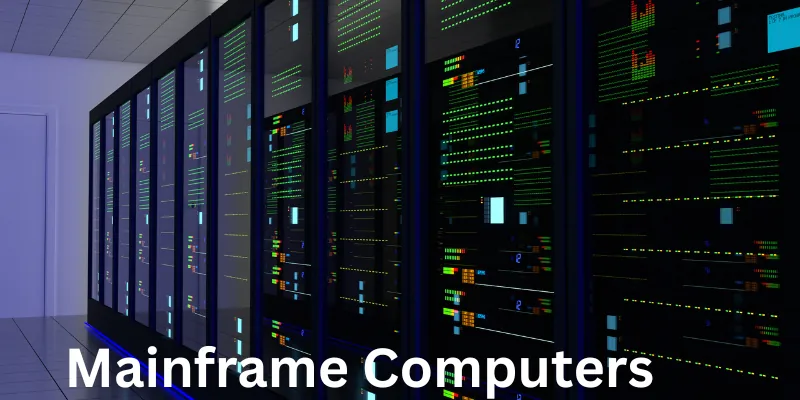“Mainframe Computers: Powering the World’s Critical Systems”
Updated: 20 Nov 2024
9
A mainframe computers is a very large and powerful machine designed to handle and process huge amounts of data at once. It can support hundreds or even thousands of people using it at the same time, and it’s capable of performing very complex tasks and calculations. Mainframes are mostly used by big organizations, like banks, government offices, and insurance companies, where reliability, security, and the ability to process a lot of data quickly are really important. Mainframes are special because they can manage a huge workload efficiently, handling many tasks at once.
Uses of Mainframe Computers
Mainframe computers are used in industries where a lot of data needs to be processed quickly and securely. Some of the most common areas where mainframes are used include:
1. Banking and Finance
- Mainframes handle back-end tasks like managing bank transactions, ATM withdrawals, deposits, and trading activities.
- They also store and process account records and transaction data for millions of customers.
2. Government
- Mainframes are used by government agencies to manage important public records, process tax information, and handle social security data.
3. Healthcare
- Hospitals and insurance companies use mainframes to store and process medical records, manage patient information, and handle insurance claims.
4. Insurance
- Insurance companies use mainframes to process claims, manage policies, and handle customer data.
5. Telecommunications
- Telecom companies use mainframes to handle call data, process billing information, and manage customer accounts.
6. Manufacturing and Logistics
- Mainframes help manage large datasets related to supply chains, production planning, and inventory in industries like automotive and electronics.
7. Scientific Research
- Mainframes are still used in research areas like weather forecasting and scientific modeling, where they help process large amounts of data.
Importance of Mainframes
Mainframes are important because they provide some key advantages for businesses that need to process a lot of data securely and efficiently. Here’s why they matter:
1. Reliability
- Mainframes are extremely reliable and can run 24/7 without crashing. They are perfect for critical tasks, like banking transactions, where downtime is not an option.
2. Scalability
- Mainframes can grow with a company. They can easily handle more data or users as the company expands.
3. Security
- Mainframes have strong security features to protect sensitive data. They are used by banks and healthcare companies because they ensure privacy and prevent unauthorized access.
4. Centralized Control
- Mainframes allow for centralized management, meaning all the data and tasks are handled in one place, making it easier to control and monitor.
5. Batch and Transaction Processing
- Mainframes excel at batch processing (doing many tasks at once) and transaction processing (handling transactions quickly), which is essential for large businesses.

Pros of Mainframe Computers
1. High Performance and Speed
- Mainframes can process tons of data quickly, making them ideal for fast-paced industries like banking or telecom.
2. Reliability and Uptime
- Mainframes are known for being reliable, with almost no downtime, which is crucial for systems that must always be available.
3. Scalability
- As a business grows, the mainframe can easily grow with it, handling more data and users without slowing down.
4. Support for Legacy Systems
- Many mainframes can run older programs, so businesses don’t need to completely overhaul their systems when adopting new technology.
5. Centralized Data
- Mainframes centralize data management, making it easier for organizations to monitor and control their data in one place.
6. Multi-User Capability
- Mainframes can handle thousands of people using the system at the same time without slowing down, which is crucial for large companies.
Cons of Mainframe Computers
1. High Costs
- Mainframes are expensive to buy and maintain. Smaller companies may find them too costly.
2. Lack of Skilled Workers
- There are fewer professionals who specialize in mainframes today, making it harder to find qualified staff to maintain them.
3. Less Flexibility
- Mainframes are less flexible than newer technologies, like cloud computing. It can be hard to integrate them with new systems or make changes quickly.
4. Perception of Being Outdated
- Some people think mainframes are outdated because newer technologies like cloud computing are becoming more popular.
5. Complex Integration
- Integrating mainframes with newer technologies (like mobile apps or cloud services) can be difficult and expensive.
6. Vendor Lock-In
- Mainframes are often tied to specific vendors (like IBM), which can make businesses dependent on one supplier for their hardware and software.
Are mainframes still used today?
Yes, mainframes are still used today, primarily for critical applications in sectors like banking, government, and large enterprises due to their reliability, security, and processing power.
What are three mainframe examples?
Three examples of mainframes are:
- IBM Z Series – Widely used in banking, finance, and large enterprises for mission-critical workloads.
- Unisys ClearPath – Used in government, healthcare, and financial industries for secure and high-performance computing.
- Fujitsu GS21 – A mainframe system used primarily in Japan for large-scale enterprise applications and cloud computing.
What is the mainframe language?
The mainframe language is primarily COBOL, though Assembler, PL/I, and RPG are also commonly used.
What is the difference between cloud and mainframe?
Cloud is a scalable, virtualized computing service accessible over the internet, while a mainframe is a centralized, physical system used for high-performance, enterprise-level computing.
Conclusion
Mainframe computers are still very important in industries that need to process large amounts of data securely and reliably, such as banking, healthcare, and government. They offer unmatched performance, security, and reliability, but they come with high costs, specialized workforce needs, and challenges in integrating with newer technologies. For large organizations with mission-critical systems, mainframes continue to be a valuable asset, even in the age of cloud computing and distributed systems.
Please Write Your Comments